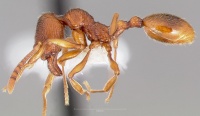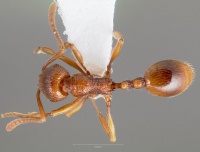Stenamma sequoiarum
| Stenamma sequoiarum | |
|---|---|

| |
| Scientific classification | |
| Kingdom: | Animalia |
| Phylum: | Arthropoda |
| Class: | Insecta |
| Order: | Hymenoptera |
| Family: | Formicidae |
| Subfamily: | Myrmicinae |
| Tribe: | Stenammini |
| Genus: | Stenamma |
| Species: | S. sequoiarum |
| Binomial name | |
| Stenamma sequoiarum Wheeler, W.M., 1917 | |
This species is known from a few collections. The types consisted of numerous workers and a female found in colonies nesting under stones in a redwood forest. Stenamma sequoiarum has also been found in oak woodland, pine forest and chaparral.
Identification
The worker can be distinguished by the following characters: Eye rather small for a Stenamma, approrimately 0.10 mm at its greatest width and with four or five ommatidia; epinotum with two well developed spines which are from one-fourth to one-third the length of the base of the epinotum; petiolar node slender and high, subconical; postpetiolar node subcampanulate, with the appearance of being longer than broad and bearing sharply defined, longitudinal rugulae; thorax above very coarsely rugulose-reticulate, the sculpturing on the promesonotum often taking a longitudinal trend, the interspaces variable in size but often 0.10 mm or more in width and rather smooth and shining; base of gaster with prominent, longitudinal rugulae, some of which are as long as 0.20 mm or more; head and thorax light brown or yellowish brown to reddish brown. {Smith 1957}
Distribution
USA. California and Washington.
Latitudinal Distribution Pattern
Latitudinal Range: 45.75° to 37.45°.
| North Temperate |
North Subtropical |
Tropical | South Subtropical |
South Temperate |
- Source: AntMaps
Distribution based on Regional Taxon Lists
Nearctic Region: United States (type locality).
Distribution based on AntMaps
Distribution based on AntWeb specimens
Check data from AntWeb
Countries Occupied
| Number of countries occupied by this species based on AntWiki Regional Taxon Lists. In general, fewer countries occupied indicates a narrower range, while more countries indicates a more widespread species. |

|
Estimated Abundance
| Relative abundance based on number of AntMaps records per species (this species within the purple bar). Fewer records (to the left) indicates a less abundant/encountered species while more records (to the right) indicates more abundant/encountered species. |

|
Biology
Castes
Nomenclature
The following information is derived from Barry Bolton's Online Catalogue of the Ants of the World.
- sequoiarum. Stenamma brevicorne subsp. sequoiarum Wheeler, W.M. 1917a: 520 (w.q.) U.S.A. (California).
- Type-material: syntype workers (number not stated, “numerous”), 1 syntype queen.
- Type-locality: U.S.A.: California, Mt Tamalpais, Muir Woods (W.M. Wheeler).
- Type-depositories: AMNH, MCZC, USNM.
- Subspecies of brevicorne: Emery, 1921f: 54; Smith, M.R. 1951a: 795.
- Subspecies of diecki: Creighton, 1950a: 137.
- Status as species: Smith, M.R. 1957b: 156 (redescription); Smith, M.R. 1958c: 117; Snelling, R.R. 1973c: 28; Smith, D.R. 1979: 1359; Wheeler, G.C. & Wheeler, J. 1986g: 34 (in key); Bolton, 1995b: 394; Ward, 2005: 67.
- Distribution: U.S.A.
Unless otherwise noted the text for the remainder of this section is reported from the publication that includes the original description.
Description
Worker
Smith (1957) - Length 3-3.5 mm. Eye rather small for a Stenamma, subelliptical, usually composed of four or five ommatidia in its greatest diameter, which is approximately 0.10 mm. Second to fifth funicular segments broader than long, the last funicular segment not as long as the combined lengths of the three preceding segments. Thorax, in profile, with distinct but variable sized mesoepinotal impression, the impression most often about twice as long as deep. Epinotum bearing two well developed spines which are approximately one-fourth to one-third the length of the base of the epinotum. Petiolar node from above and behind, usually somewhat subconical. Postpetiolar node, from above, subcampanulate, usually with the appearance of being longer than broad.
Sculpturing of head appearing rather weak and indistinct, probably due in part to the general color of the head, frontal striae fine but perceptible. Thorax, from above, very coarsely rugulose-reticulate, the sculpturing on the promesonotum often taking a longitudinal trend, the interspaces often very wide (sometimes as wide as 0.10 mm or more) and rather smooth and shining. Front coxa with distinct oblique or transverse rugulae. Postpetiole bearing sharply defined, longitudinal rugulae. Base of gaster with prominent, longitudinal rugulae, some of which are frequently as long as 0.2 mm or more. Rugulae on postpetiole and gaster sometimes not very distinct due to the color of these parts. Frontal area, clypeal furrow, epinotal declivity and gaster, smooth and shining. Rear of head, thorax, petiole and postpetiole weakly to rather strongly shining, according to the nature of the light.
Hairs on body moderately numerous but not obscuring' the ground surface, apparently more abundant on the head and gaster than on the thorax. Appendages with distinct but rather closely appressed pubescence.
Head and thorax light brown or yellowish brown to reddish brown. Petiole, postpetiole and legs yellowish. Gaster brown or blackish, usually with an even darker, transverse, median band.
Variations are as follows: The head varies from 1.10 to 1.25 times as long as broad; the basal teeth of the mandible vary in size and number, usually being from four to six; the mesoepinotal impression is usually distinct and approximately twice as long as deep but occasionally may be smaller; sometimes there is a small transverse welt at the base of the epinotum following the mesoepinotal impression, color of the head and thorax ranges from a light brown or yellowish brown to a reddish brown.
Queen
Smith (1957) - Similar to the worker excepr as described below. Length 4.3 mm. Eye slightly exceeding 0.2 mm at its greatest diameter and with 14 ommatidia. Thorax 1.65 mm in length from the anterior border of the pronotal collar to the apices of the epinotal spines; widest slightly anterior to the wing insertions where it measures approximately 0.8 mm. Prothoracic humeri lacking. Epinotal spines, from above, stout, with blunt tips, the space between the tips about three times as long as the length of the spines. Petiolar node, from above and behind, not so slender or subconical as in the worker. Postpetiole subcampanulate, about as broad as long.
Propleuron with coarse, widely spaced oblique rugulae which have a posteroventral trend. Mesopleuron and side of epinotum with similar but longitudinal rugulae, those on the mesopleuron however not as coarse as on the side of the epinotum. The rugular interspaces are so finely sculptured that they are all rather shining. Pronotum and dorsal surface of epinotum coarsely and transversely rugulose, with the interspaces similar to those on the side of the thorax.
Color similar to worker except for darkened areas around the ocelli and wing insertions.
Wheeler gave the length of the dealate female which he described as 3.6 mm.
Type Material
Muir Woods on Mount Tamalpais (near San Francisco), California. Museum of Comparative Zoology and National Museum of Natural History.
Etymology
Descriptive. The types were found within a coastal redwood forest (Sequoiadendron giganteum) and is named for the Sequoia.
References
- Creighton, W. S. 1950a. The ants of North America. Bulletin of the Museum of Comparative Zoology 104: 1-585 (page 137, Subspecies of diecki)
- Smith, M. R. 1957b. Revision of the genus Stenamma Westwood in America north of Mexico (Hymenoptera, Formicidae). Am. Midl. Nat. 57: 133-174 (page 156, Raised to species)
- Snelling, R. R. 1973. Studies on California ants. 7. The genus Stenamma (Hymenoptera: Formicidae). Contributions in Science (Los Angeles). 245:1-38.
- Wheeler, W. M. 1917a. The mountain ants of western North America. Proc. Am. Acad. Arts Sci. 52: 457-569 (page 520, worker, queen described)
References based on Global Ant Biodiversity Informatics
- Smith M. R. 1957. Revision of the genus Stenamma Westwood in America north of Mexico (Hymenoptera, Formicidae). American Midland Naturalist 57: 133-174.
- Snelling R. R. 1973. Studies on California ants. 7. The genus Stenamma (Hymenoptera: Formicidae). Contributions in Science (Los Angeles) 245: 1-38.

